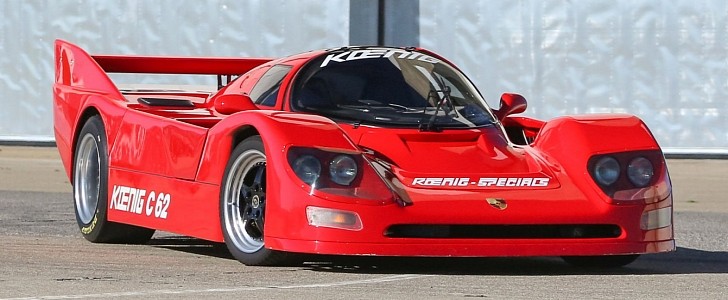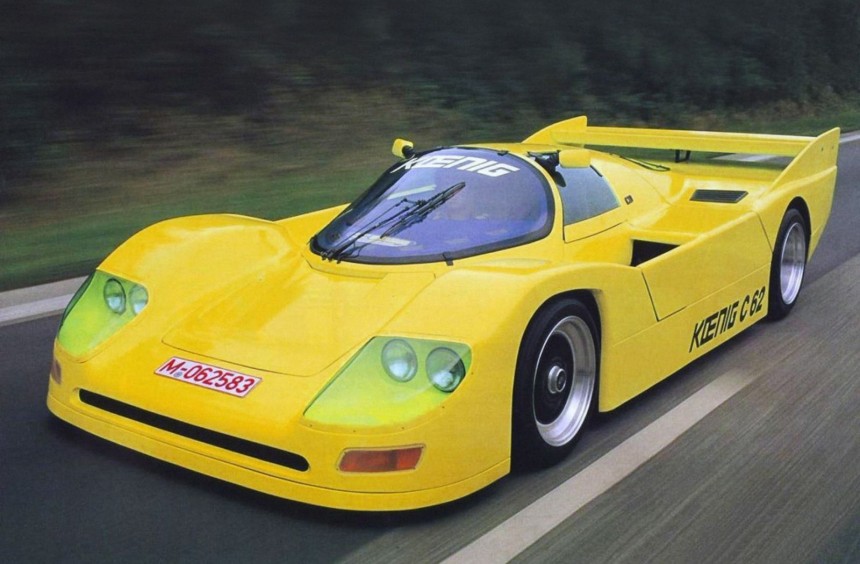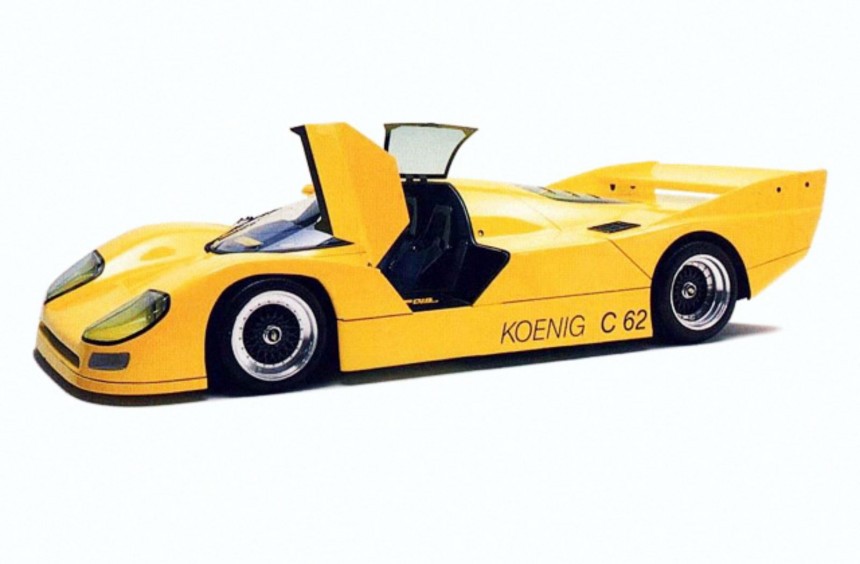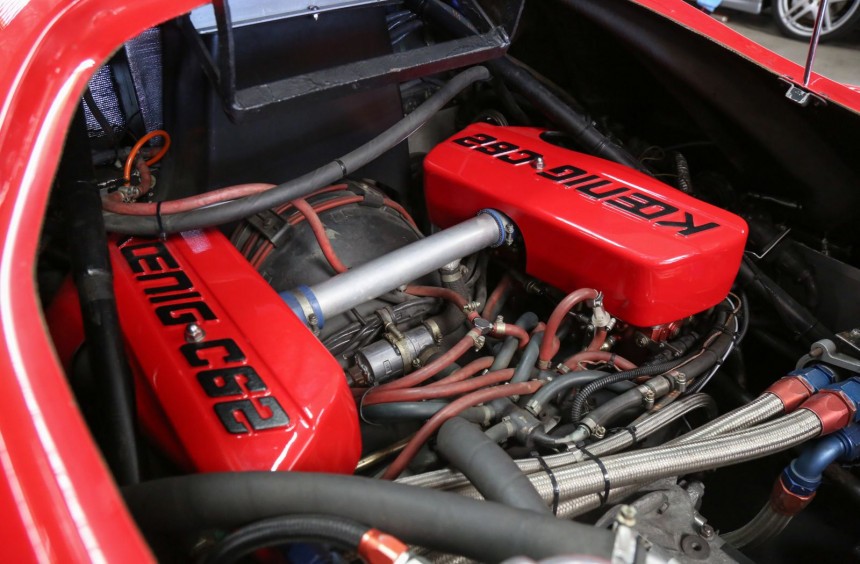Back in the early 1990s, several companies decided to transform one of Porsche’s most successful race cars into a road-worthy monster. The trend was started by the outrageous Koenig C62, continuing with the Schuppan 962CR and the Le Mans-winning Dauer 962 LM.
Like the birth of Lamborghini, the story of Koenig starts with a disgruntled Ferrari owner. In 1974, wealthy businessman Willy König received a brand-new 365 GT4 Berlinetta Boxer (BB) – one of the first units built, and the first to be delivered to West Germany.
A wealthy businessman and a thoroughbred petrolhead who won the 1962 German Hill Climb Championship behind the wheel of a 250 GT SWB Berlinetta that he modified himself, König was displeased with the performance of his newest car. But, unlike Ferruccio Lamborghini who founded an automotive manufacturing brand, the German speed addict proceeded to extensively modify his boxer-powered 365. He managed to turn the car into a tire-shredding beast, which got the attention of other Ferrari owners who commissioned him to revamp their precious rides. This led to the creation of Koenig Specials GmbH, a Munich-based tuning house that initially focused on beefing up Italian prancing horses.
During the late-1970s and 1980s, the BB and its successor, the Testarossa would receive the Koenig treatment which comprised of reworked bodies as well as engine tuning that often resulted in two times more horses than what the models were capable of delivering in factory guise.
Meanwhile, during the aforementioned decades, Porsche was dominating motorsport, particularly in endurance racing. From 1970 to 1987, it had amassed no less than twelve overall victories at Le Mans, half of which came courtesy of the 956 chassis, and its most recent evolution, the 962C.
Considered by many one of the best endurance prototypes of all time, the 962C was also the weapon of choice for many private teams from around the world. Unfortunately, by 1990 rule changes made the car prohibitively expensive to race. A handful of privateers made the required engine and chassis modifications to keep the 962C on track, but the vast majority couldn’t afford to do so and ended up selling their cars.
König used to race one himself and when he saw that 962Cs were selling for much less than their true value, he came up with the insane idea of buying some and converting them into road-legal supercars.
For several months, a few members of the Koenig Specials team took a break from their usual tuning projects and feverously worked on an initial batch of three chassis. They started by completely reshaping the bodies in order to gain the necessary road certifications. Made out of carbon fiber, the new structures were loosely based on the initial design. However, turn signals and taillights were added, the headlights stood higher, and the wheel wells were modified to allow more suspension travel.
Although similar, the three bodies were not identical. For example, the one finished in yellow that is featured in this article came with two-piece doors, while the red one that you can admire in the video below, posted on YouTube by ISSIMI Official, was equipped with one-piece variants.
Subtle differences between the three units can also be found inside but in large part, the cabin was just as spartan as that of the original 963C. The Koenig team managed to squeeze in an additional seat for homologation purposes, however fitting two people inside one of the cars obliterated any sense of comfort.
The frame of each vehicle was refurbished and strengthened. A new suspension system with softer springs and shocks was fitted, whereas the braking system received custom pads tailored for street use.
Instead of using the Type 935 3.0-liter, twin-turbo, flat-six, Koenig fitted a 911-based, 3-4-liter. Linked to the 962C’s original five-speed transaxle, the new engine - also twin-turbocharged – featured two-valve, air-cooled heads, a Bosch Motronic fuel injection system, and individual throttle bodies. It was reportedly capable of delivering up to 800 hp, but the current owner of chassis number two states that a 2019 dyno test recorded only 550 hp at the wheels, albeit with the boost limited to 1.0 bar (29 psi).
Christened C62, all three examples were finished in 1991. Initially, the plan was to produce 30 of them, but since not many people were willing to pay around $1,030,000 ($2,101,956 today) for one, and with Koenig struggling to sell the first three, the project was ultimately canceled.
Even though it was never a marketing success, this domesticated racecar remains one of the coolest rarest, and craziest supercars built in the 1990s. If you dream about owning one and you have the means, the low-mileage example featured in the video below can be purchased for “just” $995,000.
A wealthy businessman and a thoroughbred petrolhead who won the 1962 German Hill Climb Championship behind the wheel of a 250 GT SWB Berlinetta that he modified himself, König was displeased with the performance of his newest car. But, unlike Ferruccio Lamborghini who founded an automotive manufacturing brand, the German speed addict proceeded to extensively modify his boxer-powered 365. He managed to turn the car into a tire-shredding beast, which got the attention of other Ferrari owners who commissioned him to revamp their precious rides. This led to the creation of Koenig Specials GmbH, a Munich-based tuning house that initially focused on beefing up Italian prancing horses.
During the late-1970s and 1980s, the BB and its successor, the Testarossa would receive the Koenig treatment which comprised of reworked bodies as well as engine tuning that often resulted in two times more horses than what the models were capable of delivering in factory guise.
Considered by many one of the best endurance prototypes of all time, the 962C was also the weapon of choice for many private teams from around the world. Unfortunately, by 1990 rule changes made the car prohibitively expensive to race. A handful of privateers made the required engine and chassis modifications to keep the 962C on track, but the vast majority couldn’t afford to do so and ended up selling their cars.
König used to race one himself and when he saw that 962Cs were selling for much less than their true value, he came up with the insane idea of buying some and converting them into road-legal supercars.
Although similar, the three bodies were not identical. For example, the one finished in yellow that is featured in this article came with two-piece doors, while the red one that you can admire in the video below, posted on YouTube by ISSIMI Official, was equipped with one-piece variants.
Subtle differences between the three units can also be found inside but in large part, the cabin was just as spartan as that of the original 963C. The Koenig team managed to squeeze in an additional seat for homologation purposes, however fitting two people inside one of the cars obliterated any sense of comfort.
Instead of using the Type 935 3.0-liter, twin-turbo, flat-six, Koenig fitted a 911-based, 3-4-liter. Linked to the 962C’s original five-speed transaxle, the new engine - also twin-turbocharged – featured two-valve, air-cooled heads, a Bosch Motronic fuel injection system, and individual throttle bodies. It was reportedly capable of delivering up to 800 hp, but the current owner of chassis number two states that a 2019 dyno test recorded only 550 hp at the wheels, albeit with the boost limited to 1.0 bar (29 psi).
Christened C62, all three examples were finished in 1991. Initially, the plan was to produce 30 of them, but since not many people were willing to pay around $1,030,000 ($2,101,956 today) for one, and with Koenig struggling to sell the first three, the project was ultimately canceled.
Even though it was never a marketing success, this domesticated racecar remains one of the coolest rarest, and craziest supercars built in the 1990s. If you dream about owning one and you have the means, the low-mileage example featured in the video below can be purchased for “just” $995,000.




















